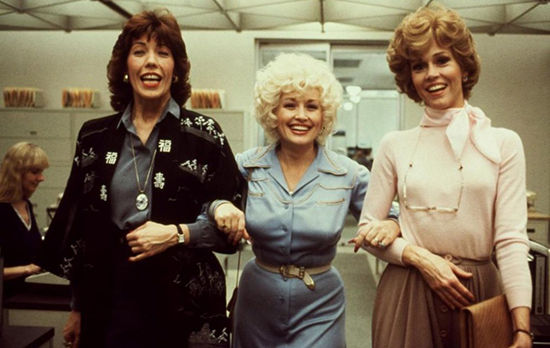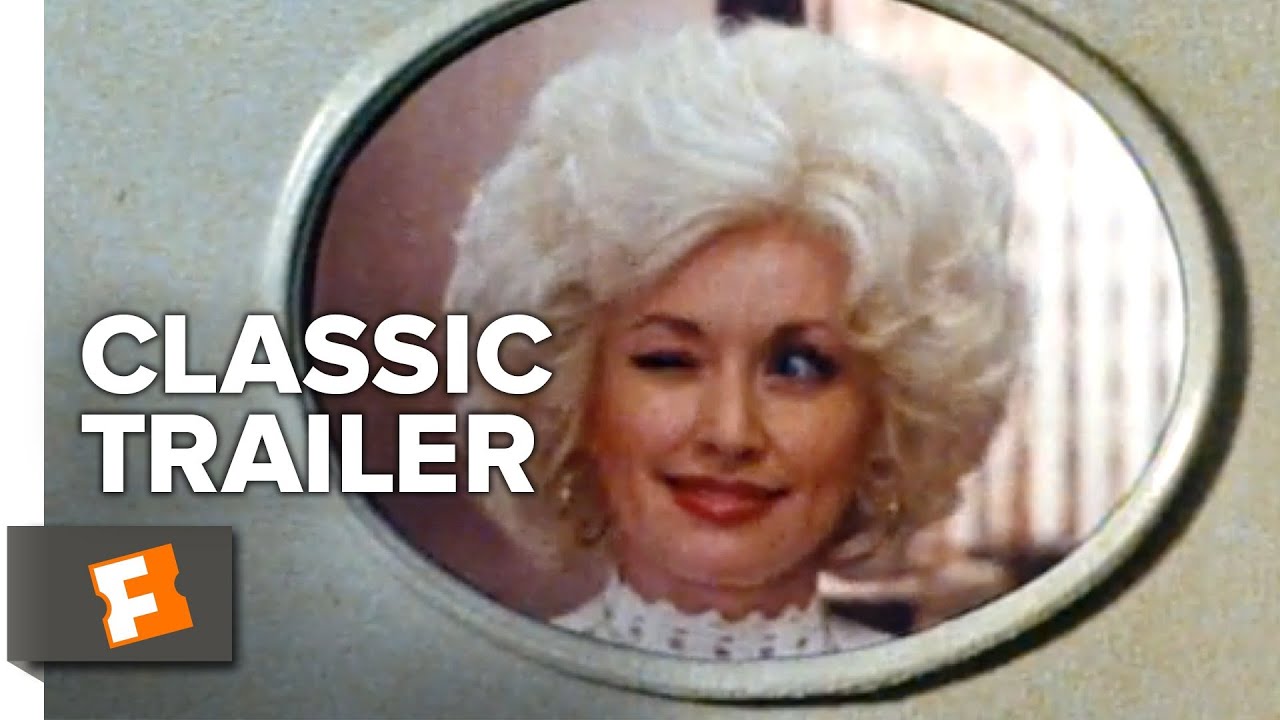There is no other film where you see Dolly Parton, dressed as a rootin’ tootin’ cowboy, trap and roast a man over an open fire. There is no other film – well no funny film, anyway – that makes clamping down on in-work sexual harassment and implementing flexi-working look glamorous. Trade union membership levels in the UK are at a dismal low, but maybe that would change if Unite got their act in gear and replaced po-faced Lexiter Len McCluskey with someone with charisma and a beehive. Dolly, are you interested?
If you’ve any taste, you’ll know I’m talking about Nine to Five, which turns 40 this year. The notion of a follow-up or remake has been pushed around and then rejected, like a bad pudding. Thank god, you can’t improve on perfection – a thought that often flits across my mind, actually, as I apply make-up. The plot – in a nutshell: lean, mean career girl Violet (played with simmering contempt by the divine Lily Tomlin) joins forces with timid divorcee Judy and sweet-natured secretary Doralee, (played respectively by Jane Fonda and Categorically The Greatest Lyricist of All Time, Dolly Parton) to teach their woeful, arse-grabbing boss, Mr Hart, a lesson. Hilarity ensues. In one excellent scene, they make like a trio of pound shop Seiu Itos, and leave Hart impotently barking at the trio of “slow-witted broads” that have had the nerve to clamp him in a harness and chain him to a dresser. In his absence, they implement a slew of progressive changes in the office: flexible working, equal pay, an in-work creche, and job shares. In a show of how quickly and clumsily fashion cycles round, the new office looks remarkably like a 2020 WeWork: all pot plants, ochre walls, and long, low furniture. The bad boss takes credit for the changes and is duly sent off to Brazil to implement them there. The girls drink champagne on his desk, cackling. Lean in, baby.
This is a feel-good ending. The contemporary viewer may not feel so good, because 40 years on she is legally entitled to only some of these changes, but – as with much in life – the gap between theory and practice is huge, a chasm. To make a follow-up when the ambitions set out in the first film have yet to be realised would be an admission of failure.
So let’s talk about work. The coronavirus pandemic has dealt a body-blow to the global economy, and governments are reeling, offering extreme solutions for extreme times. Ideas previously considered utopian are now framed as feasible: Universal Basic Income is being touted as a viable response to a slimmed-down job market; male policy-makers legally required to stay inside with their children may no longer find the idea of childcare as paid-for ‘work’ laughable.
There is a real mania for writing books about the future of work within left-wing academia right now, so if you have a healthy appetite for suffering you could read one of those: Fully Automated Luxury Bullshit, that sort of thing. But no one who has ever scrubbed a floor for money reads these books. A better way of approaching it is to think about the following: if Nine to Five were made today, what would it look like? What would its stars bargain for?
The workplace in Nine to Five is deliberately bland and non-specific, a spoof. Even the name – Consolidated Companies – is just management-speak folded in half, and Mr Hart spends his days creaming off the work of underlings and briskly shouting for reports, xeroxes, letters, all the accoutrement of productivity and output that belies that there is no real work being done. The whole office is a joke, the punchline served via memo. When Judy is hired she shakes; she has never worked before. She is baffled by the Xerox machine. Putting calls through visibly makes her nerves jangle. There is a chance Judy’s job wouldn’t exist now – the bulk of her tasks have been sleekly automated. If the film were shot today, Judy’s role would likely fall under what anthropologist David Graeber categorises as "bullshit jobs": “Tasks [the workers] secretly believe do not really need to be performed… through some strange alchemy, the number of salaried paper-pushers seems to expand” This bleak diagnosis – automation or paper-pushing – asks the question: would Judy want to work at all? Universal Basic Income is one of those ideas that excites fringes of both the left and right: right-wing libertarians tout it as a replacement for the benefits system, and many on the left just fancy it, frankly. Would Nine to Five in 2020 see Judy listlessly going through the motions of administrative work, dreaming of UBI? Or, more realistically, would she be preoccupied by how she might incrementally inch up the ladder? The application of Universal Basic Income throws up as many questions as it answers, and discussing the niceties of minimum thresholds and means-testing doesn’t exactly make for compelling on-screen viewing.
Nevertheless, Nine to Five doesn’t wear its politics lightly. Hart’s administrative assistant, Ros, gleefully agitates to stamp out unionisation, and sad-eyed office worker Maria loses her job for discussing her salary. “It’s OK,” she sighs. “I wanted to spend more time with my kids, anyway.” She returns under the new regime, doing her role in a job-share – an arrangement that is still surprisingly rare in 2020. Violet, a mother of four, is passed over for a promotion in favour of a man with “a family to support”. One touching scene sees her laughing as she repairs a garage door with her son. This is about as subtle as a push-up bra: motherhood is its own reward, which is good, because it will actively hinder your career, as fatherhood turbocharges your male colleague’s. Sure, things have improved in the intervening years, and post-Covid it will be harder than ever to deny employees the right to work flexibly and from home, a move that will overwhelmingly benefit women. But still. As Girls Aloud once sang, You can’t escape my biology. (Though they were singing about sex appeal, not the division of emotional and maternal labour). Men don’t give birth or breastfeed, and childcare in the UK is so exorbitantly costly that it is typically the woman whose career gets crunched under the juggernaut of caring responsibilities. 2020 Analysis of ONS data suggests that the unpaid work of women – including cooking, cleaning, and childcare – is worth £700bn to the UK economy. If Nine to Five were made in 2020, maybe it would be called Core working hours are 11:00-14:00, and those with caring responsibilities are at liberty to claim for time spent with their families, because we recognise that carework and housework is work, it falls disproportionately to women, and ultimately contribute to both society and the economy. But maybe that is too utopian. Not so much Lean In, as Dream On.
This is all getting a bit depressing, so let’s slink over to sexual harassment, with a detour via the film’s spectacular costumes. Parton as Doralee steals the show in every scene, effervescent in pastels, with hair as wide as her hips. Sumptuously camp. Violet and Judy initially titter at Doralee, mistaking her overblown proportions for an admission of promiscuity, a sign that she’s in bed with the boss. She isn’t – he’s harassing her, constantly. In one scene where the three women nurse their revenge fantasies, Doralee gratuitously turns the tables on their boss: “You’ve got a nice ass, Frank… I love how those pants fit your package… you’re my boy from nine to five!” Flipping gender roles to make a comedic or political point is about as obvious a move as chewing over the politics of how women dress (prickly; exhausting; boring) but the film makes light, excellent work of the former, and I’m about to have a stab at the latter. You couldn’t make a film about sexism in the workplace without torturing yourself over the hellish politics of the kitten heel, and the endless tyranny of the post-lunch pencil skirt.
There is a whispered class dynamic in how a person dresses. Career-driven Violet is slim, acerbic, and dresses accordingly – all straight-up-and-down shifts and statement jewellery. The muted sexiness of elegance – and its twin sister, slenderness – signals discipline, whippet-sleek sublimation. Frenchwoman Gabrielle Deydier shot to notoriety in 2017 after writing a book about being sacked for her teaching job, on the grounds that she “lacked commitment” because she failed to lose weight. When she accused a colleague of sexual harassment, he denied it, adding: “Why would I try to rape a fat woman?”
When I’m torturing myself on the treadmill I wonder if the trend for loose, chaste, expensive smocks in a certain kind of workplace (Yes, I do shop in Cos and have a corporate job, thanks) is both display and defence. On the one hand, you’re signalling that you’re eight miles of barre-honed lean muscle, so you look good in what is essentially a glorified hessian sack. On the other: you look sober, serious. If your skirt is shapeless enough, no-one will put their hand up it. Femininity – or an excess of it – is still associated with frivolity, hence Angela Merkel’s endless line-up of boxy power-suits. There is an obvious and specific form of sexism at play that dictates that – even in 2020 – waitresses, receptionists, flight attendants, and women in an assortment of low-paid, ‘supporting’ roles are still expected to appear ‘feminine’. Flight attendants cheerfully dispose of vomit and half-eaten self-assembly meals in tight skirts and thick, early-morning make-up. In 2016, a receptionist was sent home from a London accountancy firm for violating the temp agency’s “appearance guidelines” by not wearing high heels. Meeting this baseline expectation creates a compounded vulnerability: it is assumed that your appearance is a prompt for attention, a response; if you’re precariously employed or low-paid, the ramifications of that unwanted response could be that you lose your job and there is little you can do about it. The #MeToo movement was great for actresses – less so for waitresses, or anyone who gets paid by the hour. Femininity is a high-wire. It was in 1980, it is today. To remake Nine to Five now would be an admission that very little has changed on this front. Why torment ourselves? I haven’t gone to the cinema to suffer since Killing of a Sacred Deer came out. Why break the habit?
In short, Nine to Five wouldn’t work today. It’s a joyful buddy movie about three women who outsmart their “scheming, sexist, egotistical hypocritical bigot” boss and improve the lives of their colleagues whilst doing so. It’s fun, it’s camp, but it’s also shot through with rage. Over time, rage calcifies into weariness, boredom, contempt. I would not pay to see a movie where, 40 years on, three women wrestle with the same depressing problems. I would not pay to see a movie where some wet-eyed Momentum reject tries to push for Universal Basic Income in an economy where fewer people than ever even belong to a union. Most of all, I would not pay to see a movie where I don’t get to see Dolly Parton don a rhinestoned cowboy hat and lasso a man.



